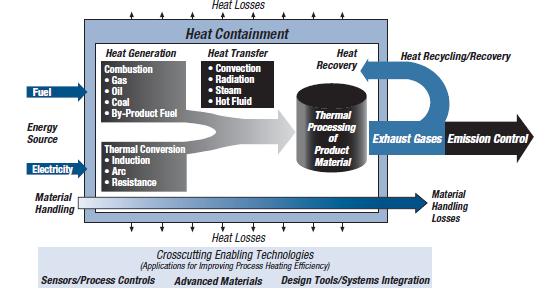Types of Process Heating Systems
The process manufacturing industry largely relies on several types of heaters that are utilized for various purposes. Though each product is slightly different in its components and principles, one thing that is the same for all the, is that heat energy is transferred to the material which has to be treated.
The direct methods are based on generating heat within the material itself whereas the indirect techniques transfer heat from another source to the material through convention, radiation, conduction or a combination of these.
Types of Process Heating Systems
In most of the discussed methodologies, an enclosure is used for isolating the system and the environment from each other. The main aim behind this is to restrict radiation within the boundaries of the system, confine the combustion of different products and control the surrounding atmosphere. In the figure below, the most essential components of a typical process heater are shown below.
 |
Combustion or Fuel Based Heaters
In these heaters, heat is produced by burning solids, liquids or gases, and is then transferred to the material directly or indirectly. The most common substances which are used as fuel are oil, coal, natural gas, wood chips, charcoal, ethanol and cellulose. Combustion is enhanced by adding oxygen or air to the material, which is either directly heated or indirectly hated.
In the direct method, there is contact between the combustion gas and the material. In the indirect method, the material is kept in confined vessels to keep it separate from the combustion gases. There are several applications of fuel based heaters such as grate, strokers and bed, which are utilized in almost every industrial sector.
Electric Process Heaters
In electrical heaters, the material is heated with an electric current or an electromagnetic field in two different ways: direct and indirect. The first of these directly heats the material by transmitting a current through it, inducing a current or more formally, eddy current, into it or exciting the electrons present in the material. The indirect method also utilizes any of these three different techniques but instead of conducting it on the material, they conduct it onto a separate heat element and then transfer the produced energy to the material.
Heat Recovery and Exchange Systems
If the manufacturing facilities require an end – use specific heating application, then energy is transferred from one process to another through a heat exchanger. Another example of a similar system is of an exothermic chemical reaction that produces energy which is then used to heat another process.
Boiler and Steam Generators
Most of the energy used in process manufacturing facilities is generated through boilers, which comprise of a complicated heating system. As such there are a lot of factors involved that can decrease the inefficiency, which is why measures must be taken to improve performance.
A boiler produces steam by fuel combustion. This approach has several advantages such as the low toxicity, easy transportation, high heat societies and lower costs when compared to other systems. A thermal fluid system is a common example of a steam generator.
